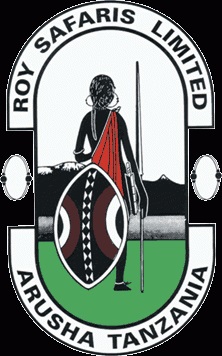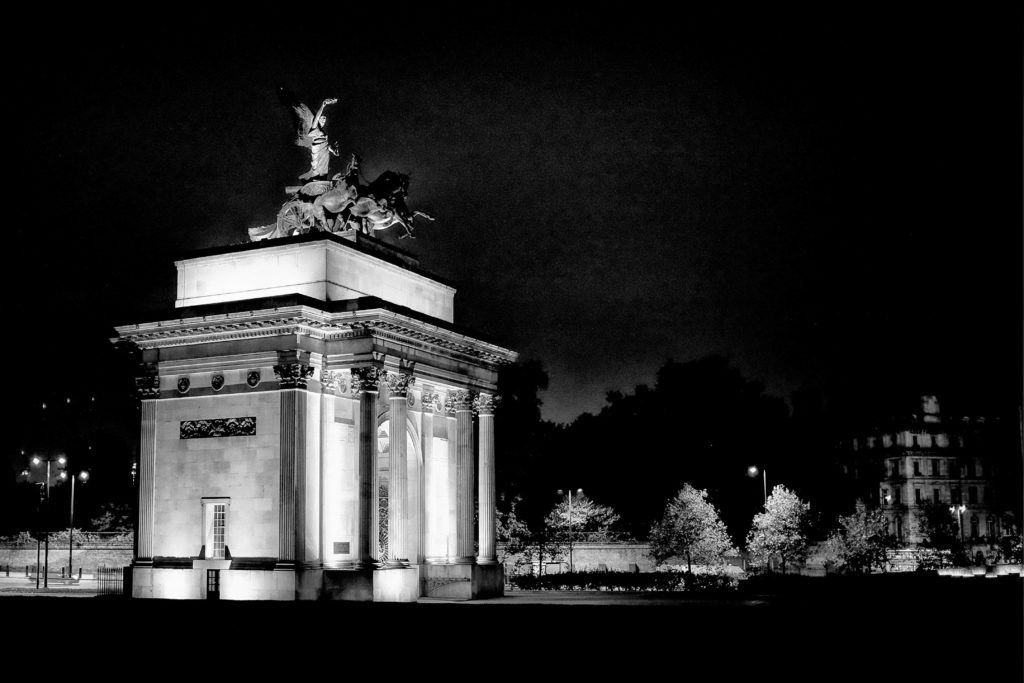
London’s public art – including statues, memorials and architectural sculptures – can be easily appreciated by taking a street or park walk. This self-guided walk starts at the south end of Oxford Street and ends just a mile away at Hyde Park Corner.
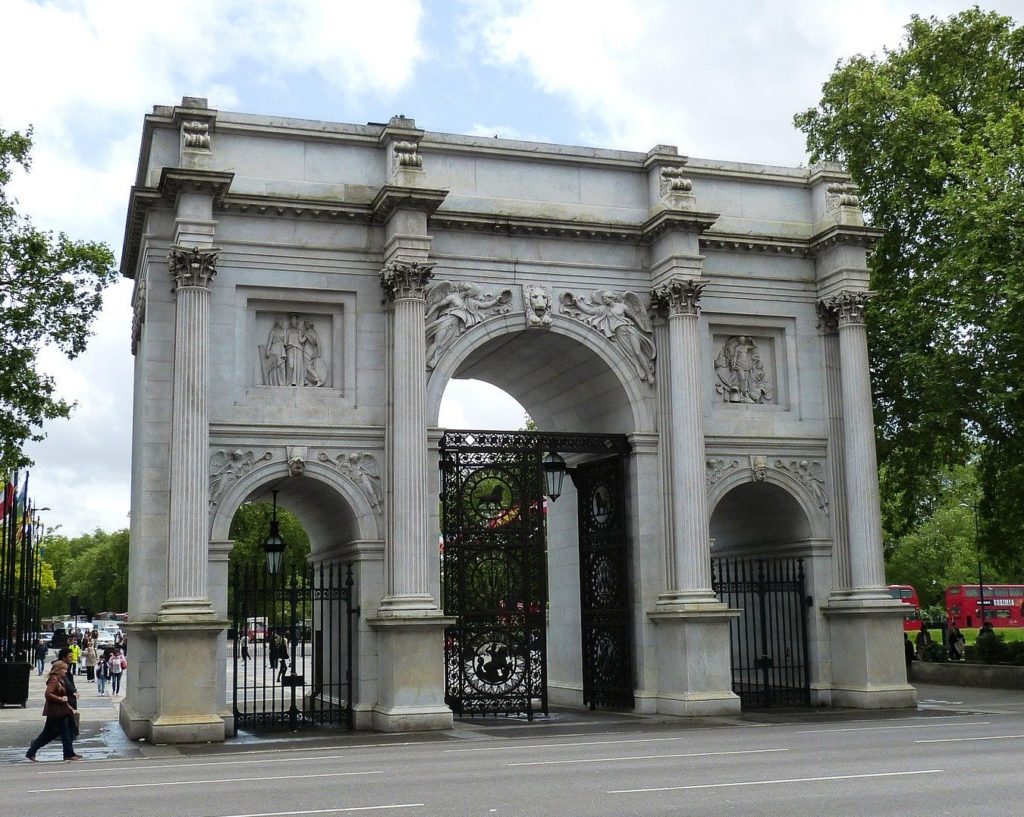
Marble Arch
1825–30
Architect: John Nash
Sculptors: Edward Hodges Baily and J.F.C. Rossi
Emerge from Marble Arch underground station or jump off a bus at the south end of Oxford Street or Edgware Road to start the walk. This London landmark originated from the patriotic fervour following the Napoleonic Wars. It was originally envisaged as being an arch to commemorate the conflict to be placed at Buckingham House that was being remodelled into Buckingham Palace by George IV from 1825. The structure had a convoluted life but ended up being a grand gateway to Buckingham Palace for 17 years. In 1850, however, it was dismantled and re-assembled at Cumberland Place by Hyde Park. The arch has given its name to this area and it housed London’s smallest police station for many decades. It’s interior, however, is not open to the public. The arch sits in a giant roundabout created in 1960 rather than being at the edge of Hyde Park. Continue your tour by walking across to Hyde Park by subway. On the north side of Serpentine Road, west of statue of Achilles (see below), is the Cavalry Memorial.
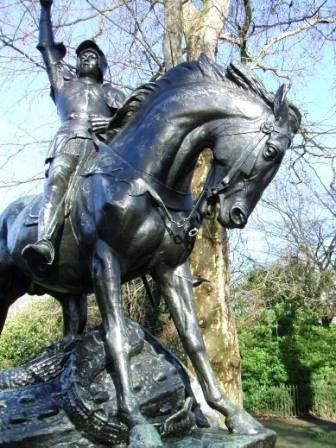
Cavalry Memorial
1924
Sculptor: Adrian Jones
This equestrian bronze depicting the legend of St George with the dragon he has killed lying dead beneath his horse was originally made for a position close to the front of the Dorchester Hotel on Park Lane. It was unveiled by the future Edward VIII in 1924. The Park Lane widening scheme (1960-62) led to the destruction of the gates and loggia that originally formed part of the monument. Behind the statue are bronze plaques (made from captured guns) commemorating the cavalry regiments of the British Empire from the First World War onwards. It is considered one of the capital’s finest memorials and a masterpiece by Adrian Jones who saw service as a vet in the British Army. Note the dragon’s tusks or whiskers have a resemblance to the upturned moustache of Kaiser William II who led his nation into the Great War in 1914. The base was designed by Sir John Burnet. The Cavalry Memorial Parade and Service normally takes place in May featuring a regimental band leading serving and former members of the cavalry regiments to a ceremony nearby. Now walk towards Queen Elizabeth Gate at Hyde Park Corner to see the towering Statue of Achilles in the south east corner of the Park and visible from Park Lane.
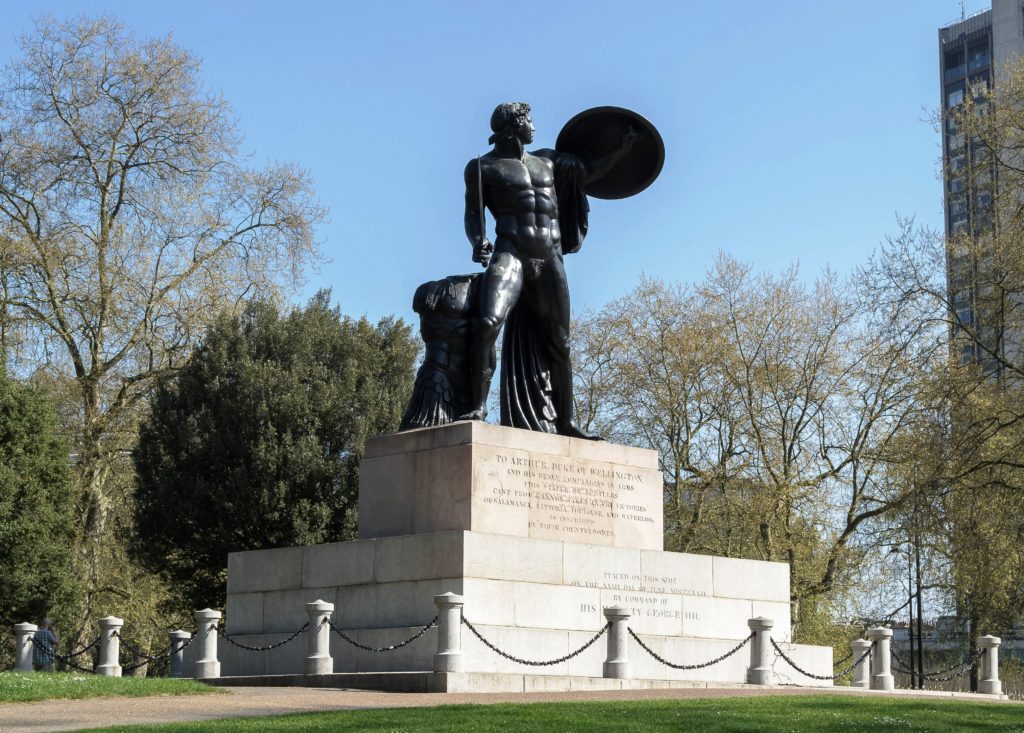
Statue of Achilles / The Wellington Monument
1822
Sculptor: Sir Richard Westmacott
This 18-ft, cast-iron figure of Achilles, the Greek hero of the Trojan War, is a tribute to the 1st Duke of Wellington (1769–1852) from ‘The Women of England’. The figure is cast with 33 tons of metal from French cannon captured during the Napoleonic Wars. The ‘heroic nudity’ of this huge memorial had never been seen in Britain when it was unveiled. This resulted in much controversy and mirth. The body of the statue is modelled on a Roman figure on Monte Cavallo in Italy. Walking to Hyde Park Corner, The Hyde Park Screen sits right by Apsley House (or No. 1 London) which was the London residence of the 1st Duke of Wellington and now houses one of the city’s finest art collections in rooms that remain largely unchanged since the early 19th century.
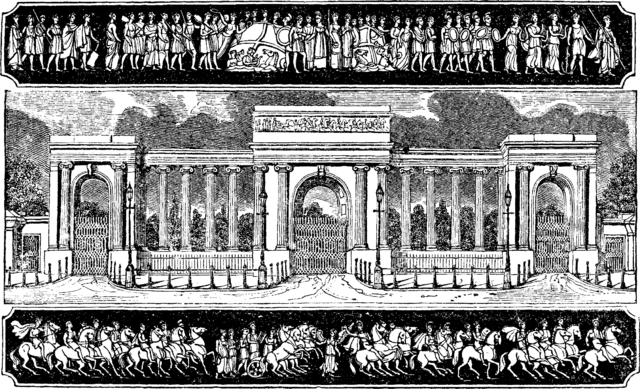
The Hyde Park Screen
1825
Architect: Decimus Burton
This was designed as a formal entrance into Hyde Park and Green Park. From the mid 1700s, Hyde Park Corner was seen as the main western gateway to London and various grand schemes with imposing arches had been envisaged. The appointed architect, 25-year old Decimus Barton, had already designed a series of lodges and gates around Hyde Park during the previous year. It was inspired by the Ionic screen by Henry Holland that stood in front of Carlton House in Pall Mall and Rousseau’s Hotel du Salm and similar works in Paris. The frieze is based on the ancient Greek sculptures and architectural details known as the Elgin (or Parthenon) Marbles, part of which were taken from Greece in the 19th century and have since been on display at the British Museum. Cross to the centre of the Hyde Park Corner roundabout to find the next monument.
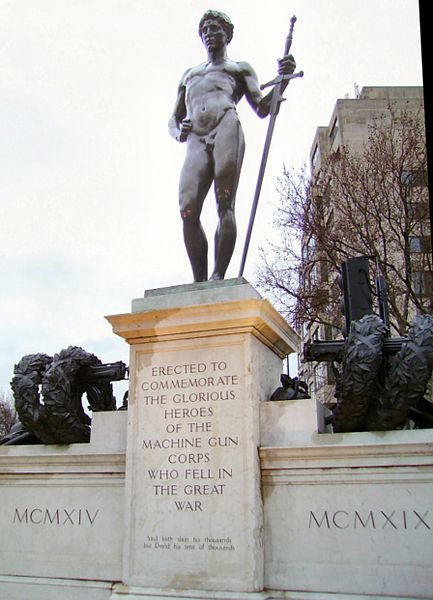
The Machine Gun Memorial
1925
Sculptor: Francis Derwent Wood
The memorial is noteworthy for the contrast in the work between a life-sized figure of the Old Testament figure David (with the sword of his defeated opponent Goliath ) and the two Vickers machine guns in bronze on either side of the statue. At the time it was unveiled, the monument’s Biblical text (‘Saul has slain thousands, and David his tens of thousands’) described as both blunt and ambiguous generated controversy. The rear of the plinth explains: “The Machine Gun Corps of which His Majesty King George V was Colonel-in-Chief, was formed by royal warrant dated the 14th day of October 1915. The corps served in France, Flanders, Russia, Italy, Egypt, Palestine, Mesopotamia, Salonica, India, Afghanistan and East Africa … The total number who served in the Corps was some 11,500 officers, and 159,000 other ranks of whom 1,120 officers and 12,671 other ranks were killed and 2,881 officers and 45,377 other ranks were wounded, missing or prisoners of war.” The memorial was re-located to its present site from a site next to Grosvenor Place in 1963. Directly infront of The Lanesborough Hotel (the site of St. George’s Hospital until 1980) is the next monument.
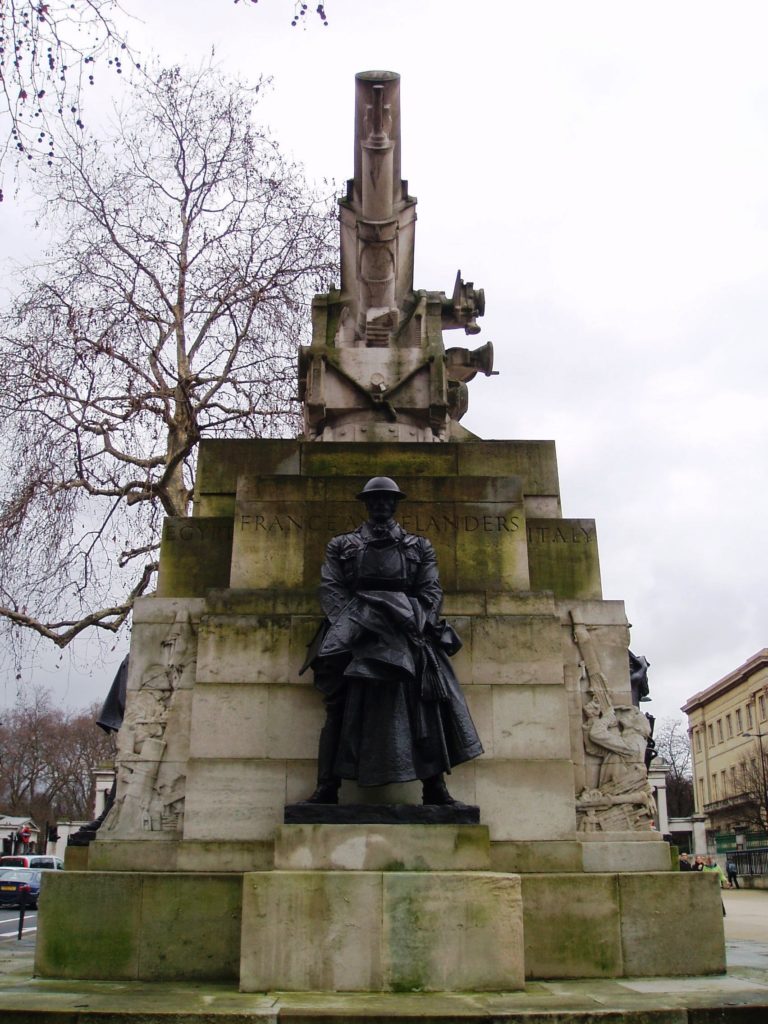
The Royal Artillery Memorial
1925
Architects: Adams, Holden & Pearson
Sculptor: Charles Sargeant Jagger
This memorial commemorates over 49,000 fallen ‘Gunners’ from the 1914-18 War and the 30,000 from the 1939-45 War. This monument, widely regarded as one of the finest pieces of public sculpture in Great Britain, was created by a sculptor who had been awarded the Military Cross for Bravery during active service with The Artist’s Rifles in the First World War. The Portland stone memorial depicts a BL 9.2 inch Howitzer Mk I gun with reliefs depicting the realities and horror of war. The north end has a fallen Gunner covered by a greatcoat. Those who died in the Second World War were commemorated by three bronze panels by Darcy Braddell on the south end. They were unveiled by Princess Elizabeth in 1949. The annual Royal Artillery Ceremony of Remembrance is held on the morning of Remembrance Sunday. Jonathan Jones wrote in The Guardian (UK): “The Royal Artillery Memorial at London’s Hyde Park Corner is an iceberg of dangerous memories, menacing the traffic that circles its island, forcing unpleasant truths from the past into the present.” Finally, turn back towards the 18-metre high Wellington Arch and the last stop on this tour.
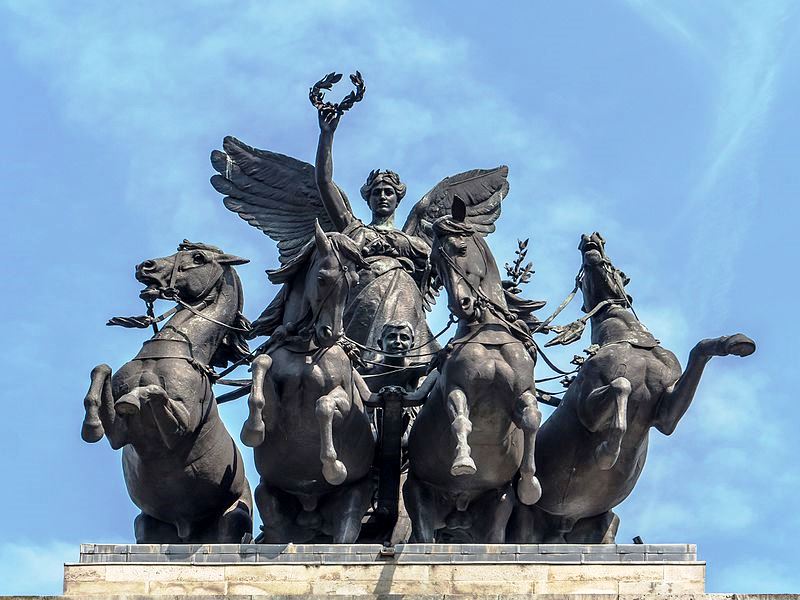
The Wellington Arch
1825-28
Architect: Decimus Burton
Sculptor: Adrian Jones
After a complex and controversial process, Queen Victoria gave Royal Assent for sculptor Matthew Cotes Wyatt to produce a design that would sit on top of an arch by architect Decimus Burton opposite the Duke of Wellington’s residence (No 1 London) that still stands at Hyde Park Corner. There was huge public disagreement over the statue that was 28ft high. It was entirely disproportionate to Burton’s arch. The House of Commons united to condemn the design but the government felt unable to withdraw the Queen’s consent. The statue was erected on the arch in 1846. It weighed 40 tons and took five years to create. A road widening scheme in the mid-1800s, to tackle the traffic congestion at Hyde Park Corner, led to The Wellington Arch being moved to its present site looking down Constitution Hill in 1883.The statue eventually ended up in Aldershot Garrison, the ‘Home of the British Army’. In 1912 a sculpture by Adrian Jones was completed depicting the Angel of Peace landing on a Quadriga (an ancient four-horse chariot) . This is the largest bronze sculpture in Great Britain and the masterpiece of Adrian Jones who had served as a military vet before becoming a sculptor and artist. Wellington Arch was isolated on a traffic island during the Park Lane widening scheme of 1960. It is now surrounded by other war memorials commemorating later conflicts. Wellington Arch is open to the public with an exhibition on the first floor and fine views across the Royal Parks and over to Buckingham Palace’s garden.
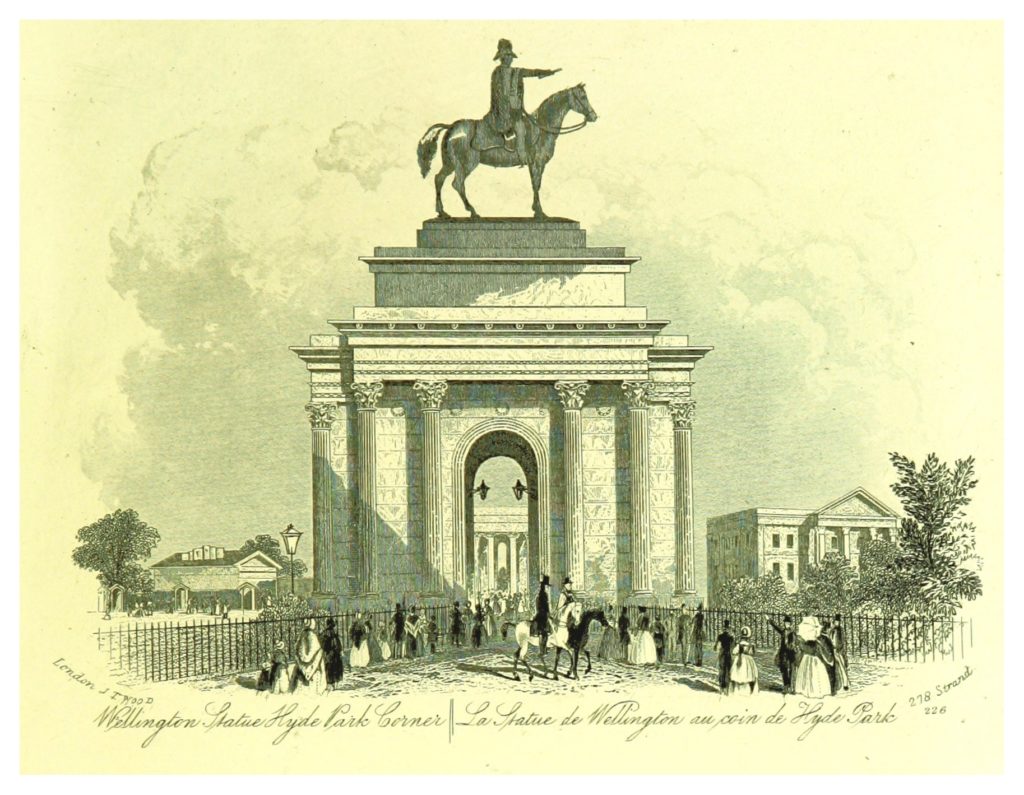
Please remember to check the latest UK government advice and guidance before making any travel plans.
Top image: The Wellington Arch, Hyde Park Corner, at night.










